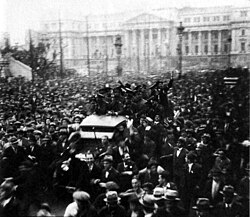Infamous Decade
Argentine Republic República Argentina (Spanish) | |||||||||
|---|---|---|---|---|---|---|---|---|---|
| 1930–1943 | |||||||||
Motto:
| |||||||||
| President | |||||||||
• 1930-1932 | José Félix Uriburu | ||||||||
• 1932-1938 | Agustín Pedro Justo | ||||||||
• 1938-1942 | Roberto Marcelino Ortiz | ||||||||
• 1940-1942 | Ramón Castillo | ||||||||
| Historical era |
| ||||||||
• Assassination of Enzo Bordabehere | 23 July, 1935 | ||||||||
• Disestablished (1943 Argentine Revolution ) | 4 June 1943 | ||||||||
| Population | |||||||||
• 1940 census | 13,320,641 [1] | ||||||||
| GDP (PPP) | estimate | ||||||||
• Total | $99.17 billion (1943) ; (expressed in international-$ at 2011 prices)[2] | ||||||||
| Currency | Argentine peso (moneda nacional) | ||||||||
| |||||||||
| History of Argentina |
|---|
 |
|
|
The Infamous Decade (
The Infamous Decade

Besides electoral fraud, this period was characterised by persecution of the
Political and economic scandals
The democratic liberal senator
CHADE (Companía Hispano Argentina de Electricidad, an offshoot of the Sofina multinational conglomerate) was also at the heart of an important political and financial scandal. The CHADE scandal, symbol of the Infamous Decade, led to investigations following the revolution of 1943 that deposed Ramón Castillo's government in a military coup, and to the subsequent Rodríguez Conde report on concessions given to the electrical companies.
Execution of Severino Di Giovanni and other anarchist show trials
In 1931, a year after the execution of the Italian anarchist
In 1942 Minister Solano Lima signed the prisoners' releases; their names were cleared by a 1993 law upheld by Socialist deputy Guillermo Estévez Boero.[5] In 2003 a law granted a pension to the daughter of one of the anarchist victims of this show trial.[5]
Justo's presidency (1932–1938)
In 1933 Arturo Jauretche took part in a failed uprising, led by Col. Francisco Bosch and Col. Gregorio Pomar in Paso de los Libres, in the province of Corrientes. He was subsequently detained.
Economic and social policy
The Roca-Runciman Treaty
It was during Justo's term that Argentina signed the
At the 1932
The treaty created a scandal, because the UK allotted Argentina a quota less than any of its dominions—390,000 tons of meat per year were allotted to Argentina in exchange for many concessions to British companies, and 85% of exportation had to be arranged through British refrigerated shippers. In addition, the tariffs of the railways operated by the UK were not regulated, the treaty did not establish customs fees over coal, had given special dispensation to British companies with investments in Argentina and had reduced the prices of their exports. So many problems resulted from the treaty that Vice President Roca, after the signing of the treaty, declared, "By its economic importance, Argentina resembles just a large British dominion." [citation needed] Lisandro de la Torre, one of Roca's principal and most vociferous opponents, mocking his words in an editorial, wrote, "In these conditions we wouldn't be able to say that Argentina had been converted into a British dominion because England does not take the liberty to impose similar humiliations upon its dominions." [citation needed]
The National Democratic Party, one of the parties that had supported the nomination of Justo for President, had split because of this controversy. Finally the Senate rescinded the treaty on July 28. Many workers strikes followed the deliberations, especially in
Import substitution industrialization and Pinedo's economic policies
On the other hand, the trade isolationism of the world powers ultimately prompted the beginning of Argentine industrial development via
Under the direction of
The Juntas Reguladores Nacionales were also created during this period, aimed at developing private and state activities and controlling the quality of products, both for national consumption and for export.[8] In order to support prices of products and avoid overproduction, the Juntas destroyed entire loads of corn, used as fuel for locomotives, despite popular hunger.[8] Thirty million pesos per year were spent to destroy wine products.[8]
Furthermore, Pinedo launched a national project of road construction, the national network reaching 30,000 kilometers in 1938 (although many remained without pavement).
Notable exceptions to these conservative policies were the policies of
However, fearing electoral defeats for the Concordancia both in Santa Fe and in the Electoral College, Justo ordered military intervention in the Santa Fe Province on October 3, 1935, sending the Colonel Perlinger and the minister Joaquín F. Rodríguez to take control of the local government.[11] Armed resistance against the federal intervention occurred, but in order to avoid a bloodbath, Molinas and De la Torre rejected the resistance.[10] Rodríguez soon abrogated again the 1921 Constitution and progressively dismantled Molinas' achievements.[10]
Justo had already ordered intervention in the
The workers' movement
At the time of the 1930 coup, three
Meanwhile, the syndicalist current of the CGT was discredited, because of its supporting alliance with the government in order to achieve social advances, while the socialist current proposed open opposition, tied to political support to the Socialist party. The syndicalist current was in particular affected by its agreements with the pro-
Although the
Ortiz and Castillo administration (1938–1943)
Federico Pinedo, still Minister of Economy, presented on 18 November 1940 an "Economic Reactivation Plan", which was to implement some protectionist measures and building of social lodging in order to face the crisis. He also proposed the nationalization of the British railways, having agreed upon advantageous terms for their owners with them beforehand. However, the conservatives voted against his plan, which led him to resign.[17]
During World War II, Argentina maintained the same neutrality it had adopted during the
He was replaced by his vice-president Castillo, who began to work to launch the candidacy of
June 1943 coup
On 4 June 1943, the nationalist faction of the army, gathered around the
Presidents of the Infamous Decade
- José Félix Uriburu (1930–1932)
- Agustín Pedro Justo (1932–1938)
- Roberto Marcelino Ortiz (1938–1940)
- Ramón S. Castillo(1940–1943)
References
- ^ https://biblioteca.indec.gob.ar/bases/minde/4si2_7.pdf.
{{cite web}}: Missing or empty|title=(help) - ^ "Gross domestic product (GDP)".
- ^ "Las cuentas pendientes del Desarrollo Humano". 4 February 2011.
- ^ a b Felipe Pigna, Los Mitos de la Historia Argentina, 3, ed. Planeta, 2006, p. 285
- ^ a b c d Los "presos de Bragado", historia que culmina después de 70 años Archived 2008-12-07 at the Wayback Machine, Clarín, 15 October 2002 (in Spanish)
- ^ Felipe Pigna, 2006, pp. 265–281
- ^ The New York Times, "Blasts Kill Three in Buenos Aires", 21 January 1931.
- ^ a b c d e f g h i Felipe Pigna, Los Mitos de la Historia Argentina, 3, ed. Planeta, 2006, p. 284
- ^ a b c d e f Felipe Pigna, 2006, p. 289
- ^ a b c Felipe Pigna, 2006, p. 290
- ^ Felipe Pigna, 2006, pp. 290–292
- ^ a b c d e Felipe Pigna, 2006, p. 297
- ^ Spanish: Somos una Argentina colonial, queremos ser una Argentina libre. Quoted by Felipe Pigna, 2006, p. 296
- ^ Felipe Pigna, 2006, p. 296
- ^ a b c d Felipe Pigna, Los Mitos de la Historia Argentina, 3, ed. Planeta, 2006, p. 286
- ^ Alberto Belluci, Monumental Deco in the Pampas: The Urban Art of Francisco Salamone Archived 2023-01-14 at the Wayback Machine, The Journal of Decorative and Propaganda Arts, Vol. 18, Argentine Theme Issue (1992), pp. 91–121. (in English)
- ^ Felipe Pigna, 2006, pp. 298–299
- ^ a b Felipe Pigna, 2006, p. 302
- ^ Felipe Pigna, 2006, p. 304
Bibliography
- Nállim, Jorge. "Between the Local and the Transnational: New Historiographical Approaches on Argentine Political History, 1930 to 1943." Estudios Interdisciplinarios de América Latina y el Caribe 25.1 (2014): 103–120. online
- Felipe Pigna, Los Mitos de la Historia Argentina, 3, ed. Planeta, 2006 (reed. 2007)
- Gisela Cramer, "Argentine Riddle. The Pinedo Plan of 1940 and the Political Economy of the Early War Years", Journal of Latin American Studies, 30 (octubre 1998), pp. 519–550
- Gisela Cramer, "Pre-peronist Argentina and the Origins of IAPI", en: Iberoamericana Vol. 2, No. 5 (2002), pp. 55–78.
- Juan José LLach, "El Plan Pinedo de 1940, su significado histórico y los orígenes de la economía política del peronismo", Desarrollo Económico (enero-marzo 1984)
External links
- Década Infame at Todo-Argentina (Spanish)
- Portal Planeta's article Archived 2006-04-11 at the Wayback Machine (Spanish)


